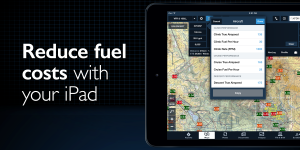
There’s little question that the digital chart revolution and subscription-free ADS-B weather led to the iPad’s success in aviation. But when you think about it, even the most sophisticated aviation apps are still displaying the same aviation data that was available prior to the introduction of the iPad, including weather reports and forecasts, graphical flight planning tools and airport/facility information.
The difference now is that this information is presented in a much more meaningful way, taking advantage of the iPad’s touchscreen capability and intuitive software design. This allows you to view and interact with the data in better context, like seeing your planned route on top of a digital sectional, with radar imagery, PIREPs and graphical winds aloft all shown at the same time.
In addition to weather, today’s iPad apps can also provide you with a wealth of data to assist in fuel planning. There are a lot of variables that come into play here, including winds aloft, airplane performance, airport service availability, and of course fuel prices. Here we’re going to look at series of tips to help you use your iPad to make the most of this decision-making process and reduce your fuel expenses.
1. View fuel prices on the moving map. This is probably the single most helpful tool when you need to plan a fuel stop on a longer trip or decide on an airport at your destination. In many of the apps you can select a Fuel Price overlay (either 100LL or Jet A) on the moving map and display this info right along with your flight plan. This takes the guesswork out of the equation to make sure you’re getting the best deal on fuel.
2. Find self-service fuel and operating hours in the FBO directory. Finding an airport selling 100LL for less than $3/gallon along your route may seem like an incredible deal, but it’s completely useless if the FBO is closed when you get there. Make it a point to check out the FBO directory in your app after finding the price on the map to verify operating hours and determine whether it’s full or self-service price.
3. Create a detailed performance profile for your airplane. Apps like ForeFlight and Garmin Pilot allow you to create custom performance profiles for the aircraft you fly most often. Here you can enter basic values like true airspeed and fuel burn for cruise, but you can also go further and enter optional data for climbs and descents, including true airspeed, climb/descent rate and fuel burn. Take the time to fill out these profiles in their entirety so that the app will more accurately estimate fuel burn for the entire flight based on your winds aloft at the selected altitude. It’ll also make the ForeFlight Altitude Advisor feature more accurate since it will account for climb/descent speed and fuel burn using greater precision (see next tip).
4. Use the Altitude Advisor to find the optimum altitude. ForeFlight users can take advantage of the Altitude Advisor tool to help save fuel, which is accessed from the Altitude button at the lower left of the Route Editor in the maps tab. This will display the total headwind/tailwind component, time en route and fuel burn for your current flight plan for various altitudes based on the active aircraft profile. This can help you determine the optimum altitude based on the winds aloft to get the best possible groundspeed and lowest fuel burn.
5. Use the graphical winds aloft to determine optimum routing. In addition to using the Altitude Advisor, consider viewing the graphical winds aloft points on the moving map along with your flight plan to determine routing that will provide the best tailwind (or minimize headwind). With ForeFlight and Garmin Pilot you can display these wind barbs starting at 3,000′ MSL and increase that altitude well into the flight levels. We’ve found this to be very useful when flying across low pressure systems to visualize and make the most of the counter-clockwise rotation.
6. Store your cruise performance charts in the document manager. If you fly the same airplane day in and day out you probably have your basic performance numbers committed to memory. But if you fly less frequently or find yourself using round numbers for performance planning, you’d probably benefit from a periodic review of the performance charts in your POH. The problem, though, is that these are never around when you’re flight planning, because they’re stored in an inconvenient location like your office or in the airplane. Change up your routine by taking a few pictures of these charts with your iPad’s camera and store them in your app’s document manager. Now you’ll always have this data at your fingertips and you’ll be surprised at the fuel savings you can achieve by reducing power by just a small percent when flying by the numbers.
7. Use weight & balance tools to optimize fuel load. Along the same lines as the last tip, many of us estimate the loading on each flight and tend to err on the conservative side during flight planning. Instead of this “ballpark” approach, consider using one of the weight and balance apps available (including one built right into ForeFlight) to more accurately determine airplane loading. This will allow you to know precisely know how much fuel you load on the airplane and take advantage of situations when the fuel price is favorably low.
Source: Ipad appsUse your iPad to help reduce fuel costs






